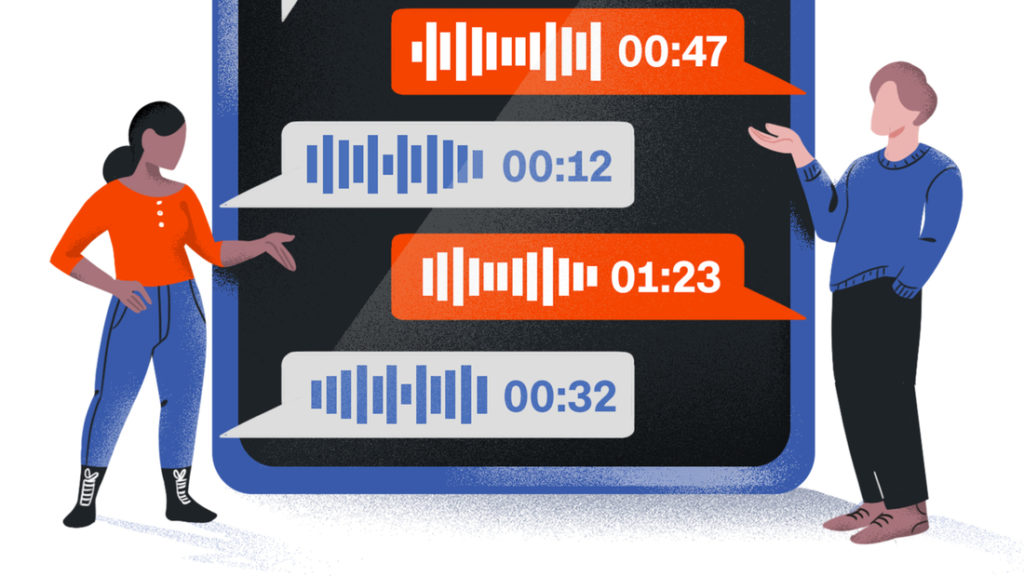“This is my way to debrief and tell everybody what’s going on,” she told CNN Business. “It’s not like it used to be where I would wait until I was going to see my friends over the course of the next week for drinks or for brunch.”
For years, Apple and others have offered the option to record short messages and send them via text and chat apps. But the format has gained new appeal for many in the United States during the pandemic as we approach a year of limited opportunities to socialize with friends, family and coworkers.
Romina Hyskaj, a 23-year-old recruiter who lives in New York City, uses them mainly to keep in touch with her parents who live six hours away, noting that “it can get your tone, attitude, or joke across.” Nick Hofstadter, a 38-year-old luxury travel adviser in Los Angeles, sends voice notes to a handful of close friends, mostly to tell funny stories with a more “dramatic effect” and to avoid sending long text messages. (He prefers using voice notes on iMessage over Instagram so he can listen to it before sending.)
And it’s not just voice messages. Voice is having a moment — and the tech industry is taking notice.
Facebook, which already offered voice messages in several of its products, said it’s seen this format increase in usage on Messenger in the US over the past year. Discord, which offers voice channels, is also immensely popular. (Apple declined to comment on usage of its voice memos.)
“Instead of typing something and hitting Send, you’re engaged in a back-and-forth dialogue with others,” they wrote. “The intonation, inflection and emotion conveyed through voice allow you to pick up on nuance and form uniquely human connections with others. You can still challenge each other and have tough conversations — but with voice there is often an ability to build more empathy. This is what drew us to the medium.”
Voicemails 2.0?
“It feels like a 1990s flashback when chat rooms were all the rage … the same thrill of interacting with strangers, the same challenges of managing inappropriate and hostile behavior, and the same curiosity from users about learning about a new technology,” said Jeffrey Hall, a professor of communication studies at the University of Kansas and the author of the recent book “Relating Through Technology.”
“Maybe people find it more enjoyable right now because of the shut-in feeling of the pandemic and the desire to connect with others, even strangers,” he added. But Hall cautioned that like chat rooms, voice chat apps could “fall by the wayside” as people move on to other things when life goes back to normal — with the possible exception of a “small niche of users” who could choose to stick with this format.
Voice messages, in particular, have long been popular in other parts of the world, with some using them to do everything from interact with delivery workers to chatting with loved ones who live overseas without having to “think about the time zones you’re in,” according to Aleena Khan, who runs a cosmetics startup in Dubai and uses the feature. Himanshi Parmar, a 27-year-old visual designer and artist in Goa, India, has also found voice notes can help cut across generational barriers with her mom, who “hates typing and hates using the phone.”
“For so many of us, we’re separated from family and friends right now,” said Carla Bevins, an assistant professor at Carnegie Mellon University’s Tepper School of Business who specializes in online and interpersonal communication. “Using voice notes lets us imbue closeness, love, and connection within our messages.”
Hall said an added part of the appeal — beyond conveying more emotional nuance — is how easy voice notes are to record, store and replay.
“Back when we had answering machines, people used to save important messages, particularly from loved ones, sometimes for as long as the machine had space and power to store those messages,” he said. “People don’t use voicemail in the same manner, partly because the phone is not the easiest way to leave a message for another person — that would be a text.”
Prior to the pandemic, Giuliani said there were many friends she didn’t talk to daily. Voice notes have changed that.
“It’s kept some of my friends and I really close together,” she said. “We send over voice notes and we’re chatting every single day, way more than we ever did before the pandemic.” She added: “I can’t believe that we didn’t before.”
You may also like
-
Afghanistan: Civilian casualties hit record high amid US withdrawal, UN says
-
How Taiwan is trying to defend against a cyber ‘World War III’
-
Pandemic travel news this week: Quarantine escapes and airplane disguises
-
Why would anyone trust Brexit Britain again?
-
Black fungus: A second crisis is killing survivors of India’s worst Covid wave

